
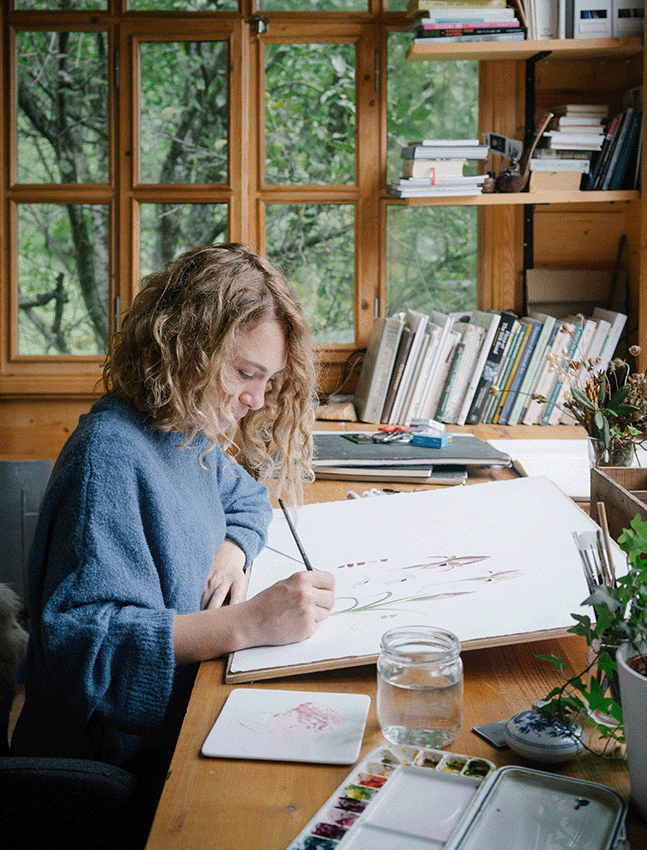
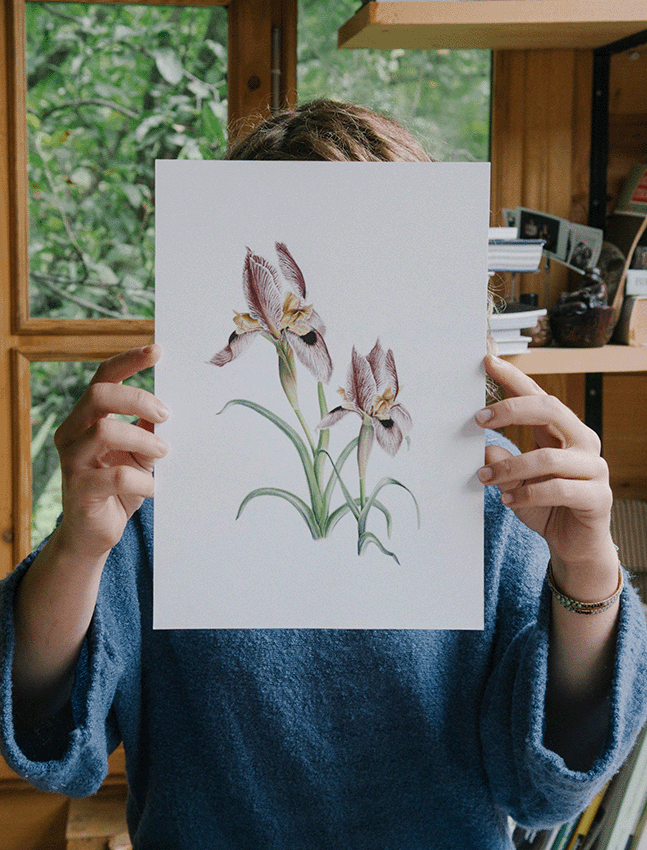

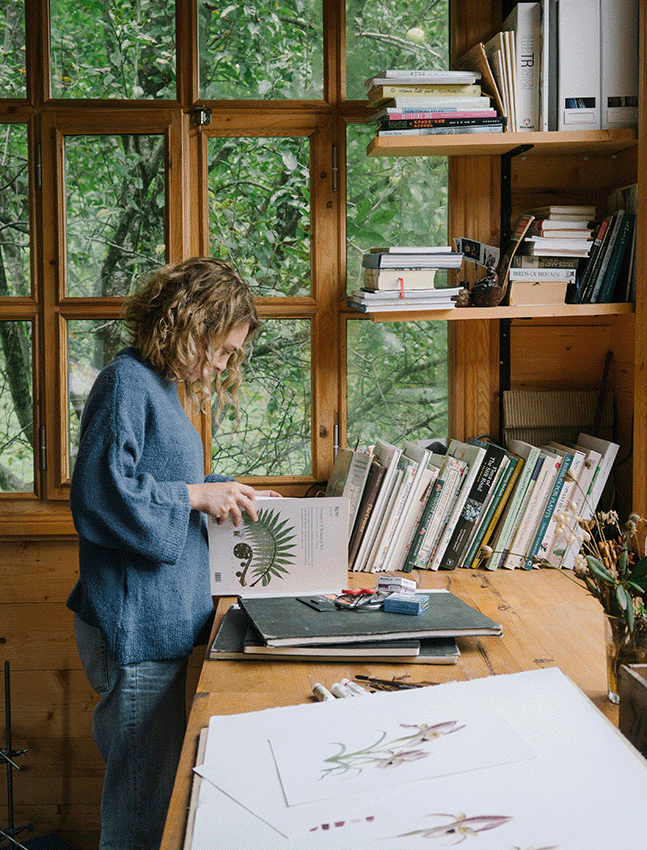
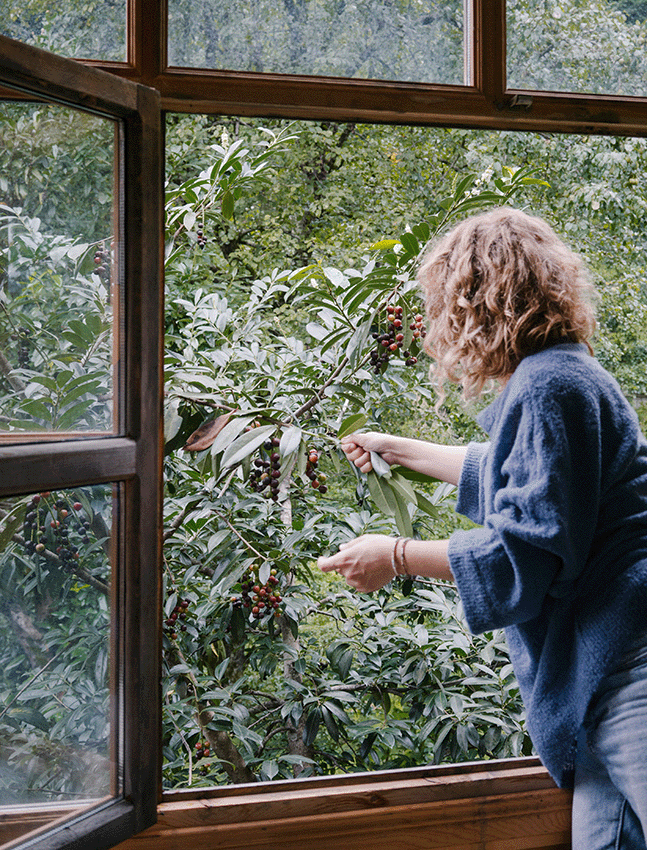


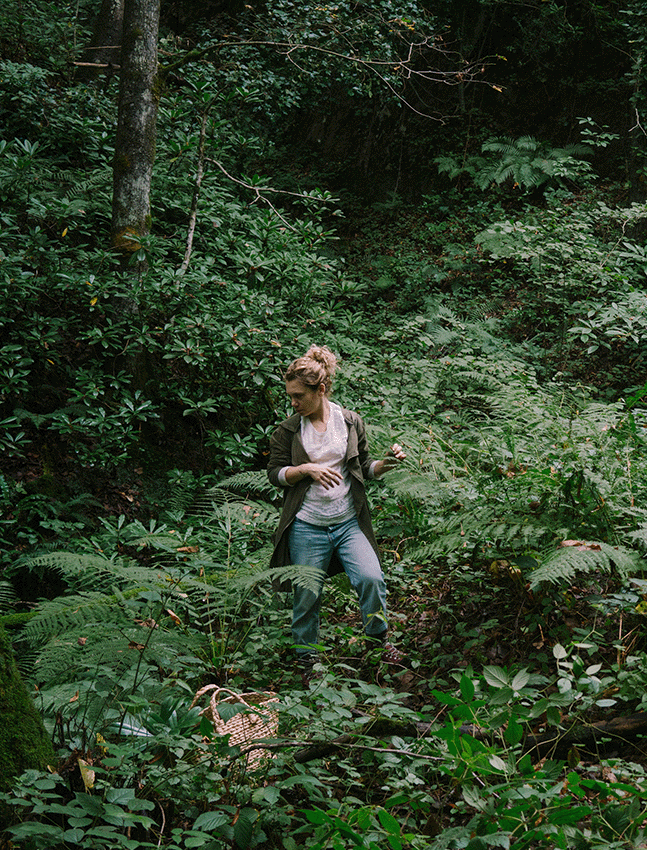
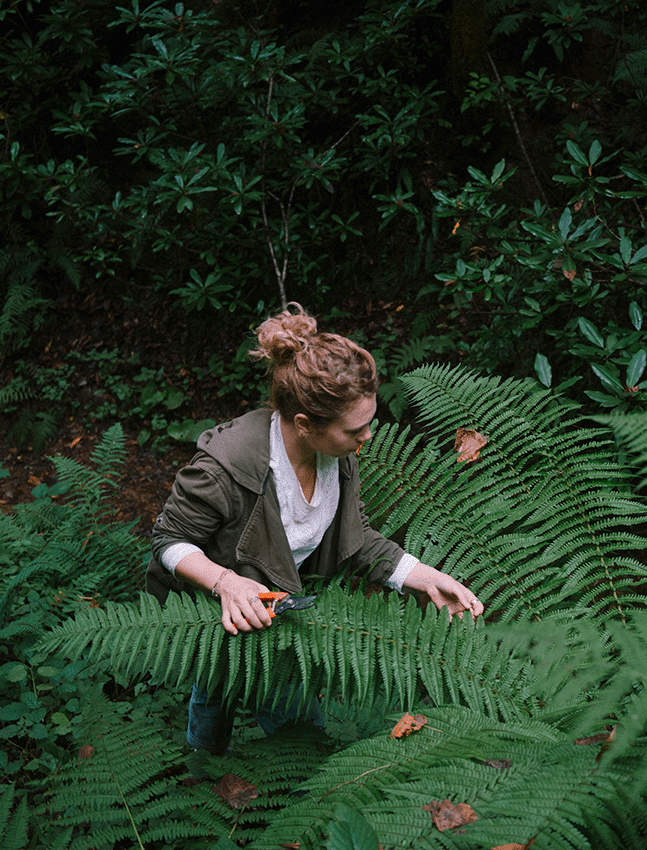
Ölümsüz Bitkiler
Işık Güner

Doğa’nın ortasında sessiz fakat içinde fırtınalar kopan ahşap bir studio’ya sahip Işık Güner, ölümsüzleştirdiği bitkileri yeşil ve doğa severlerle buluşturan bir botanik ressamı. Yurt içinde ve yurt dışında sayısız sergiye katılmış ve ölümsüzleştirdiği doğa harikaları için ödüller kazanmış benim için eşsiz sanatçı Işık. Fırçasıyla dokunduğu her rengi doğru yerlere dağıtan, ortaya çıkardığı her resmin uzansanız gerçek bir çiçeğe dokunacakmışsınız hissini yaratan, doğanın en gerçek dostuyla tanışmaya hazır mısınız?
Gördüğümüzde hayran kalmamanın imkansız olduğu resimler yapıyorsun Işık. Doğadaki güzellikleri bu şekilde resmetmeyi nasıl seçtin?
Botanikçi bir babanın kızıyım. Kendimi bildim bileli, babam Türkiye’nin her bir tarafına gider, arazilerde bitkiler toplar, bunları kurutur, fotoğraflar, bolca araştırmalar yapar. Beni ilk arazisine altı yaşımdayken götürmüştür, Muğla’da Akdağ’a çıkarmıştı. O bitki toplardı, bende yanında dolanırdım, izin verdiği kadarıyla bitkileri kurutmasına yardım ederdim. Bitkilerle olan alakam, botanik bilimine olan aşinalığım çok eskidir. Üstüne bir de Çamlıhemşin’liyiz, doğanın tam ortasından, dağların kalbinden. O yüzden bitkiler benim hayatımda hep vardı. Çocukluğumun aşkı da resim yapmaktır ayrıca. Belki her çocuk kadar, ama ben hiç bırakmayanlardanım. Yani bitkiler ve resme olan ilgim çocukluğumdan gelir.
Bitki ressamlığı ile tanışmam ise uzun yıllar sonra, üniversite sırasında olmuştur. Çevre Mühendisliği okurken, bitkilerin resimlerini yapmanın, bilimsel olarak doğru çizimlerini hazırlamanın tadına ufak ufak varmaya başladım. Ancak bitki ressamlığını bir meslek olarak yapmak, ilk başta benim seçimim olmadı. Tamam, bitki ressamlığı mükemmeldi, içinde bitki var, resim var, bilim var. Bütün kuvvetli yanlarım bir arada toplanmış gibi, ama yine de bunu meslek olarak yapmak değildi niyetim, sadece bitki resimleri yapmaktı. Neticede mühendis olacaktım, gidişat onu gösteriyordu.
Benim tek seçimim, mezun olduktun sonra, herhangi bir mastır programına devam etmeden bir sene okumaya ara vermek oldu.Tabii ki bu seçimi yapmamda, o sene, 2006’da gerçekleşen ve Türkiye’nin güneyinden muhteşem bir şekilde izlenebilecek olan Tam Güneş Tutulmasının, mastır sınavları ile aynı zamana denk gelmesinin ufak bir etkisi olabilir. Ben güneş tutulmasını seçtim, mühendisliğe bir sene ara verdim, ve o sene, yıllar önceme göre, çok güzel resimler yaptım, sürekli ürettim.
Resim yaptıkça, yaptığım resimler geliştikçe, bundan az da olsa gelir elde etmeye başlayınca, kendi kendine ilerleyen bir süreç oldu. O senenin sonunda artık bitki ressamı olarak ufak adımlar atmaya başladım.
Ülkemizde sanat çok yavaş şekilde ilerliyor. Sen nasıl bir süreçten geçtin bulunduğun konuma gelebilmek için? Nasıl yer edindin bu alanda?
Benim sürecim sürekli resim yapabilmekten geçti. Bu alanda kendimden çok resimlerim yerini aldı. Yaptığım çalışmalarda, resmin kendisinden öte, bitkiyi ön planda tutmaya çalıştım hep. Bitkilerin kim olduklarını açıklar gibi yapıyorum resimleri, estetiğe özen göstererek, ama gerekirse feda edilebilecek bir kavram olarak yaklaşıyorum. Bilimsel olarak daha doğru resimler yapabilmek, bitkileri en iyi, en yalın hali ile anlatabilmek için geliştirdim kendimi. Detaylara odaklandım, çok fazla detaya. Yaptığım çalışmalarda botanik bilimi açısından doğu olunca, kendine yer açtı bu alanda.
Bu kadar doğayla iç içe olan bir insan olduğun için doğanın sana neler düşündürdüğünü, neler hissettirdiğini ve nasıl bir bağınız olduğunu merak ediyorum?
Benim doğa ile olan iç içeliğim yine çocukluğumdan gelir. Şehirlerde büyüsem bile, bir ayağım hep doğanın tam ortasında oldu. İlişkimizin çok eskilere dayanması ve hiç kopmaması, bu bağı gittikçe kuvvetlendirmiştir, ancak bir o kadar da normalleştirmiştir. Yeşilin tam ortasında yaşıyorum, ama her gün kendimden geçmiyorum. Sabah kalkıyorum, kuş sesleri, dinliyorum. Karşımda dağlar, derin bir nefes alıyorum. Akşam olurken çakalların sesi, yine dinliyorum. Ve bu her gün oluyor, şükrediyorum.
Tabii hayatımın bu kadar içi olunca yeşil, bitkiler, ağaçlar, doğa, alışıyorsunuz. Ferahlığa, genişliğe alışıyorsunuz. Sadece etraftaki yaban hayatının sesi, ormanın o inanılmaz kokusu, uzaktan gelen derenin sesi, bir yandan normalleşirken, diğer yandan içinizin ta orta yerine işliyor ve uzak kalamıyorsunuz. Gerçekten kalamıyorsunuz, beyin ve vücut hata vermeye başlıyor.
Bitkilerle uğraşmanın meditasyon etkisi yarattığı söyleniliyor. Fiziksel olarak toprakla uğraşmak için doğru bir yaklaşım, fakat resim içinde aynı şeyleri söyleyebilir miyiz? Senin üzerindeki olumlu etkilerinden biraz bahsedebilir misin?
Resim yapmak beni anda tutuyor, ne geçmişe gidiyorum, ne geleceğe. Düşüncelerimi düzenliyor, hislerimi dengeliyor. Aklen daha sağlıklı, daha kuvvetli bir birey olmamı sağlıyor. Resim yaparken, bütün endişelerimin uçup gittiğini, daralan kalbimin ferahladığını bilirim. Beni hayatta en çok zorlayan kavramlardan bir tanesi hep zaman olmuştur. Hiç yettiremedim şu zamanı kendime. Günler hep kısa geldi, saatler hızlı hızlı geçti, geçiyor. Koskoca dünya bir çırpıda dönüveriyor. Yetişemedim zamanın hızına bir türlü. Ama işte resim yaparken zaman kavramı yok oluyor. Ne duruyor, ne akıyor, ortadan kalkıyor. En çok o hali seviyorum. Hal böyle olunca tabii, uzun uzun resim yapabiliyorum. Masanın başından kalkmak çok kolay olmuyor. Tabii zaman kavramının benim için yok oluşu, dünyanın dönüşünü durdurmuyor. Ben resme gömülmüş, detayların arasında kendimi kaybederken, aklen ve kalben arşa ererken, elim, belim, sırtım, gözlerim bazen can çekişmekte. Ama tabii ki resim yapma eylemi benim için bir meditasyondur. Bitkilere dokunmak, görmek apayrı bir meditasyon.
Türkiyede ki bitki örtüsü senin resimlerine ilham olması açısından yeterince zengin mi? Yoksa daha çok yurt dışındaki bitkileri mi resmediyorsun? Bize biraz bu süreçlerden bahsedebilir misin?
Türkiye bitki örtüsü açısından inanılmaz zengin bir ülke. Üç tarafımız deniz, ne tür iklim ararsan var, bu da, bu toprakları gerçekten bitkiler açısından çok verimli ve çeşitli kılmaktadır. Bırakın Türkiye’yi sadece Fırtına Vadisi’nde olan bitkiler bile bana hayat boyu ilham ve çok çeşitli seçenekler sunacaktır. Keyifle, zevkle resmedeceğim binlerce tür mevcut bu topraklarda. Ancak yurdışında ki bitkilerin resimlerini yapmakla hep daha fazla meşgul oldum ben şuana kadar. Kimi resmettiğim bitkiler bana çok yabancı. Gittiğim her yerde tanımadığım, bilmediğim, ilk defa gördüğüm bir sürü tür ile tanıştım. Son derece keyif alarak yapıyorum tabii bu uzak topraklardaki bitkileri, ama bunun nedeni tamamen projelerle ve bu projelere ayrılan ödeneklerle alakalıdır. Yani yurt dışındaki bir bitkinin resmini yapmam için, diyorlar ki, şu kadar bütçemiz var, gel yap. İşin maddi yönü, bazen seçimlerimizi mecburileştiriyor. Ama resmedeceğim, tabii ki resmedeceğim. Fırtına Vadisi’nin bir dağında yaşıyorum ben, orada ki bitkileri ben değil de kim resmedecek.
Çamlıhemşinden çok güzel bir atölyen var. Neden orada yaşamayı seçtin?
Ben işimden ve seçimlerimden dolayı çok çeşitli yerlerde yaşadım. Yıllardır Edinburgh, Barselona, İstanbul üçgeninde gidip geldim. Sürekli seyahat ediyorum, ve hala da etmekteyim. Barselona’da birkaç sene yaşadım, bu süre içerisinde Edinburg’da çalıştım. Bir ara İstanbul’a dönme girişimim oldu, başaramadım. Sonra göçebe hayata başladım. 3 yıl kadar göçebelik yaptım, evim yoktu, ama bolca projem vardı. İngiltere, Şili, Çin, Nepal, İspanya gibi ülkelere bu projeler için sürekli gittim geldim. Kendim, ufak bir valiz, dev gibi bir portfolyo olarak seyahat ettik. Bolca resim yaptım gittiğim her yerde. Bu göçebe döneminde oradan oraya zıplarken, bir yandan da sürekli yer baktım kendime. Nerde yaşamak istediğimi bilemediğimden bu süreç uzadı da uzadı aslında. Hiç bir yere kalbim ısınmadı, hiç bir yerde duramadım. Şımarıklığımdan değil, neyin doğru olduğundan emin olamadığımdan.
Sonra yine kafamda aynı sorular devam ederken, 2015 Nisan ayında, Nepal’de, o dev gibi Himalayalar’ın bir köşesinde, arkadaşımla yürüyorum. Yine hedef dağlar. Ve tam bu sırada deprem oldu, 8.1 şiddetinde. Nepal’i darmaduman, Katmandu’yu al aşağı eden bu deprem, dağdayken beni hiç korkutmadı. Dağlar bütün ihtişamıyla sallandı, ama korkutmadı. İşte bende o deprem esnasında dağlara yakın yaşamak istediğime karar verdim, ve Çamlıhemşin’e yerleştim. Dağlardır benim derdim, onlara yakın olmak aslında. Hep daha huzurlu, daha güvende hissetmişimdir ben yüksek dağlarda.
Şimdi yeşilin tam ortasında, bana hayat boyu resim malzemesi sağlayacak Fırtına Vadisi’nde yaşıyorum. Aslında bakarsanız, ben daha çok kış aylarını geçiriyorum Çamlıhemşin’de. Seyahatlarim yine devam etmekte, ama dönecek bir evimin olması, hele de bu evin dağların eteklerinde olması, paha biçilemez.
Bitki ressamlığına bizim ülkemizde ilgi var mı? Ya da büyümeye müsait bir potansiyel görüyor musun?
2008 yılında, Nezahat Gökyiğit Botanik Bahçesi’nde ilk ‘Bitki ressamlığı’ kursumu düzenledim. Bu kurs için, posterler hazırladım, her yere astım. Üniversitelere gittim, botanik hocaları ile görüştüm, öğrencilerine iletmelerini rica ettim. Tanıdık tanımadık, herkese haber verdim. İlk kursuma sekiz kişi katıldı. Daha sonra düzenlediğim hiç bir kurs için böyle çabalarım olmadı. Kurs der dermez doldu derslerim ve şuana kadar katılımcı azlığından hiç kurs iptal etmişliğim yoktur. Yani bitki ressamlığının büyüme potansiyeli olduğunu bilmem on sene öncesine dayanır, ki bu süre içerisinde o kadar değerli ressamlarımız yetişti ki, biz de bu sebeple ‘Resimli Türkiye Florası’ Projesini yapma cesaretini bulmuşuzdur. Türkiye’de ki bütün bitkilerin resmini yapmak niyetindeyiz yani.
Türkiye de botanik üzerine gelişmiş seralar ve bahçeler malesef çok yok diye biliyorum. Ya da benim bildiklerim gerçekten bir elin 5 parmağını geçmeyecek kadar az. Senin bu konuda bize önerebileceğin yerler var mı? Nerelere gidip görebiliriz doğa harikalarını?
Ben en yakından, İstanbul, Nezahat Gökyiğit Botanik Bahçesini bilirim. Ataşehir’de otaban kavşağına kurulmuş, son derece ilginç bir lokasyonda, çok değerli çalışmaların yürütüldüğü, tam olarak aktif bir botanik bahçesidir. Sürekli gelişmekte, eğitimler vermekte ve çok değerli koleksiyonlar edinmektedirler. Resimli Türkiye Florası Projesi gibi bir çok projenin ev sahipliğini yapmaktadır. Görülmeye değecek, aktivitelere dahil olmak güzel olacaktır. Öğrenecek çok şey var Nezahat Gökyiğit Botanik Bahçesi’nde.
Yurt dışında görebileceğimiz botanik bahçesi ve seralara önerilerin var mı?
Nereleri keşfedebiliriz?
Bunun içinde yine bildiğim, yıllardır çalıştığım Edinburg Kıraliyet Botanik Bahçesi’ni önerebilirim. Zaten Edinburg’un her yeri bahçe, birde şehrin ortasında böylesine aktif, çok ciddi araştırmaların yapıldığı, dünyanın her tarafından toplanmış bitkileri görebileceğiniz bir botanik bahçesi olması harika. Gönül bağımdan dolayı, benim en sevdiğimdir.
Bu arada, bunları Denver Botanik Bahçe’sinden yazıyorum. Benim de yeni tanıştığım, yine şehrin ortasında, çok küçük, tatlı bir bahçe. Oldukça rengarenk çiçeklendirmişler her tarafı. Bende yeni tanıştım bu bahçe ile, bir süredir burada resim yapıyorum, yeni yeni keşfediyorum. Ancak sanırım olurda bu kadar uzaklara yolunuz düşer ise, Kolorado’nun dağlarına gitmenizi daha fazla öneririm. Yabani bitkiler hep daha fazla ilgimi çekmiştir.
Bu kadar bitkiden sonra evinin de bitki dolu olduğunu düşünüyorum :) Bitki bakımı konusunda başarılı mısın? Kaç çeşit bitki büyütüyorsun?
Aslında öyle değil. Çok fazla bitkim yoktur, hatta birkaç kaktüs, sukulent gibi bitkilerin dışında bitkim yoktur. Bitki bakım ister, elini üstünden çekemezsin kolay kolay. Ben çok fazla ve uzun uzun seyahat ettiğim için, bitkilerim genelde ölmekteler. Bende bitkileri öldürmek yerine, vazgeçtim onları yanımda tutmaya çalışmaktan. Onun yerine yeşilin tam ortasına, ağaçların hemen yanına, her tarafı cam olan bir atölye kurdum. Şimdi bir çamdan karayemiş, öbür camdan elma toplayabiliyorum. Benim için yeterli sanırım bu kadar yeşil.
Aslında yine tam olarak mesleğimden dolayı, bitkileri yetiştirmekten çok, üzerinde çalıştığım bitkileri öldürüyorum. Bilimsel bitki resmi genel olarak masada gerçekleşir. Arazide bir takım çalışmalar yapar, bitkileri bulur, fotoğraflar, eskizlerini yaparsınız, ama ölçekli, tam ve doğru bir çalışma hazırlamak için, eğer çok ender bitki değil ise, o bitkiyi alır, çalışma masanıza getirirsiniz. O yüzden bir bitkinin resmini yapıyorsam, genelde, yüksek ihtimal ile resmini yaptığım birey ölecektir. Tabii resmini yaparak onu ölümsüzleştirdikten sonra.
Son zamanlarda yenilebilir çiçeklerin sık sık yeme içme sektöründe kullanıldığını biliyorsundur. Mutfakla aran nasıl? Yeteneklerin mutfağı da etkiliyor mu?
Mutfakla aram dönemsel olarak değişmekte. Evde olduğum dönemler bir aşçıyım. Seyahat ettiğim dönemler, yemek yeme alışkanlıklarım da, pişirme becerilerim de değişkenlik göstermekte.
Benim genelde yemek yapma aşkım mutfaktan gelir. Kullanışı rahat ve temiz bir mutfakta, uzun uzun çalışabilir, o zaman gerçekten lezzetli yemekler yapabilirim. Kendi mutfağımda, kendime göre konforlu bir ortam oluşturdum ve yemek yapmak son derece keyifli. Pilitam var (kuzine), kışın ısınmak için kullanırken, leziz fırın yemekleri hazırlamak için de mükemmel. Çok severim fırın yemeklerini, birde odun ateşiyle çalışan bir fırınınız varsa, her akşam efsane yemekler yapabilirim.
Oldukça deneysel bir yaklaşımım vardır ancak yemek konusunda. Elimde olan malzemelere göre, yeni yemekler yaratmaya bayılırım. Bu sebeple bir yaptığım yemeği bir daha yapmam zor oluyor, ancak ev ekonomisi konusunda son derece pratiklik kazanıyorsunuz. Tarihi geçmiş, ya da çürümüş bir yemek malzemesini çöpe attığım çok nadirdir.
Yaşamış olduğun zaman diliminde doğayla aranda geçen ilginç bir hikaye var mı?
Geçtiğimiz sene kış aylarında, atölyemin konforlu ortamındayım. Her taraf bembeyaz kar yağmış, ama hava temiz, gökyüzü kısım kısım mavi. Böyle bir günde Skype üzerinden Edinburgh ile bir görüşme yapıyorum, konumuz kurslar, dersler. Oturduğum yerden de karşıda ki dağın sırtını, çaylık alanları görebiliyorsunuz. Tam bu toplantı esnasında, kafamı bir kaldırdım, iki tane kurt, karşıdaki sırttan aşağı doğru iniyor. Bir tanesi bir hayvan sürüklüyor, ne olduğunu tam anlamadım ama sanırım domuzdu. Diğeri de etrafı kolaçan ediyor. Bizim köyün insanları için muhtemelen son derece normal bir durumdu, ama benim için çok heyecanlı bir andı. Tabii benim çığlıklarımla beraber bu noktadan sonra toplantı bitti, olan biteni Edinburg’a canlı yayın yapmakla uğraştım. Anı paylaşma ihtiyacı sanırım.
Doğanın biz şehirlilere bir mesajı var mı?
Sanırım doğanın adına konuşmam gerçekten güç olur. Doğaya temas ettiğinizde, bu soruyu kendinize siz sormalısınız, kendiniz cevap vermelisiniz. Kendinizin ne istediğine değil, doğanın ne istediğine kulak vermelisiniz. Doğa ne ister? Doğa yaşamak ister sanırım. O yüzden şehirliler, köylüler farketmez, hepimizin doğada bıraktığı izleri silmesi gerekmektedir. Geride ayak izimizi dahil bırakmamalıyız. Doğa vahşi kalmalı. Kısacası olduğu gibi bırakılmalı. Eğer bunu başaramıyorsak, kendimizi şehirlere kilitlemeliyiz, saksıda yetiştirdiğimiz çiçeklerle yetinmesini bilmeliyiz.
En yakından tanık olduğum Fırtına Vadisi’nin hali insanın içini burkuyor, gözlerini dolduruyor. Bu topraklarda yaşayan birçok canlı türü can çekişmekte, yok olma tehdidi altında. Bu dağlara yapılacak olan dev gibi yollar ile birlikte, bu yok oluş kesinleşecek. Bunu sadece dimdik yamaçlara yapılacak, dev gibi yollar tek başına başarabilir. Ancak birde her sene bu topraklara akın eden binlerce insan var. Maalesef buraya gelen insanlar, buranın doğası için gelseler bile, doğanın ne istediğini bilmemekteler. En güzel yerde, en güzel fotoğrafı çekmek tek ilgilendikleri, arkalarında bıraktıkları çöp yığınını görseniz inanamazsınız. İnanması çok güç, ne olursa olsun inanması güç. Bazen unutmuş olabilirler mi diye soruyorum kendime? Bilemiyorum... Kalbim kırgın Fırtına Vadisi’ne gelen şehirlilere.
Sanırım doğa’nın bizlere vereceği en güzel mesaj, "önce kendinizi eğitin, sonra ziyaretime gelin" olurdu.
Işık Güner
words: Sinem Uysal
photography: Ekin Özbiçer
